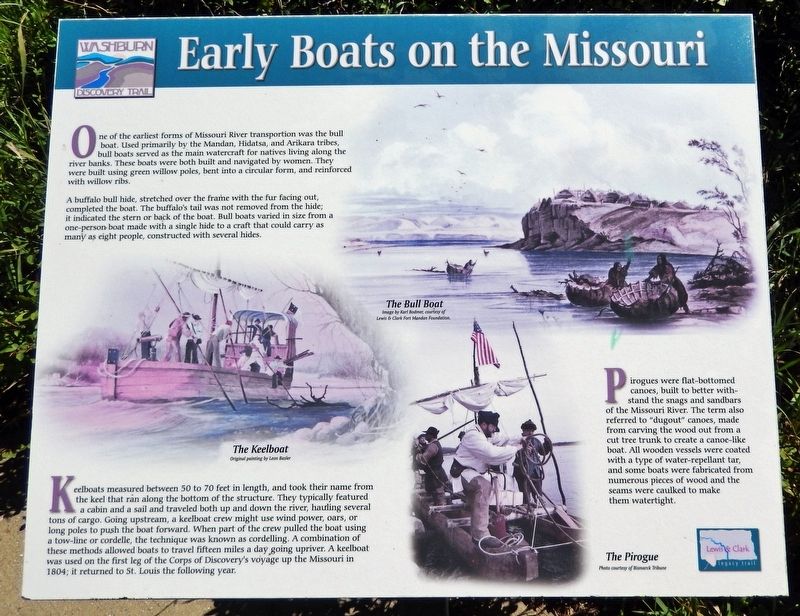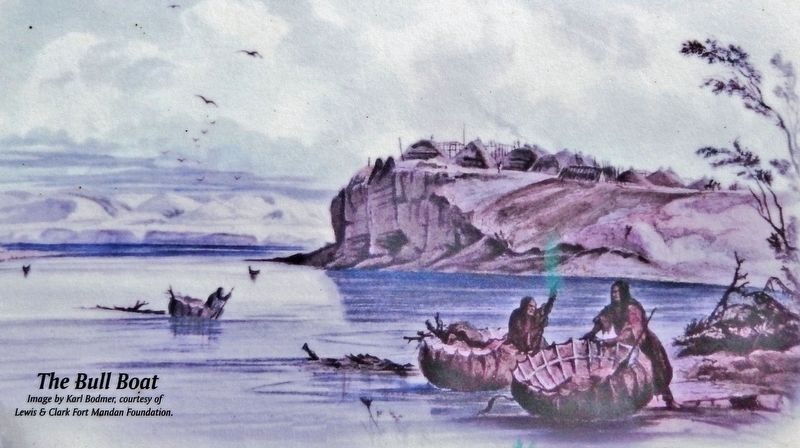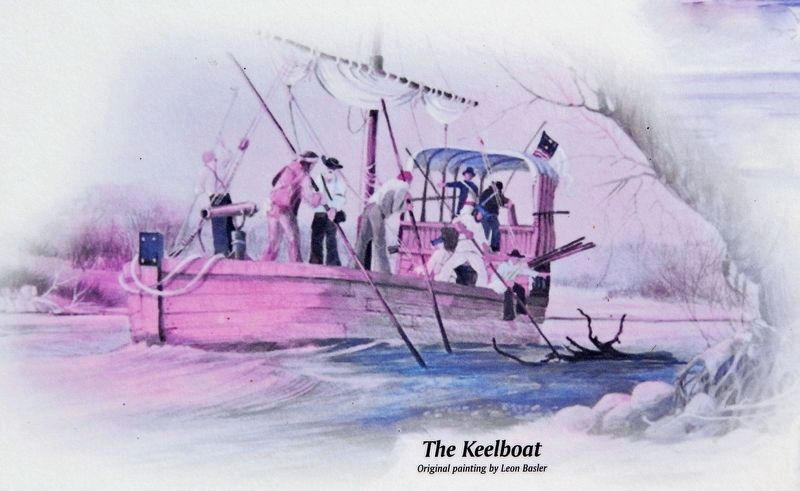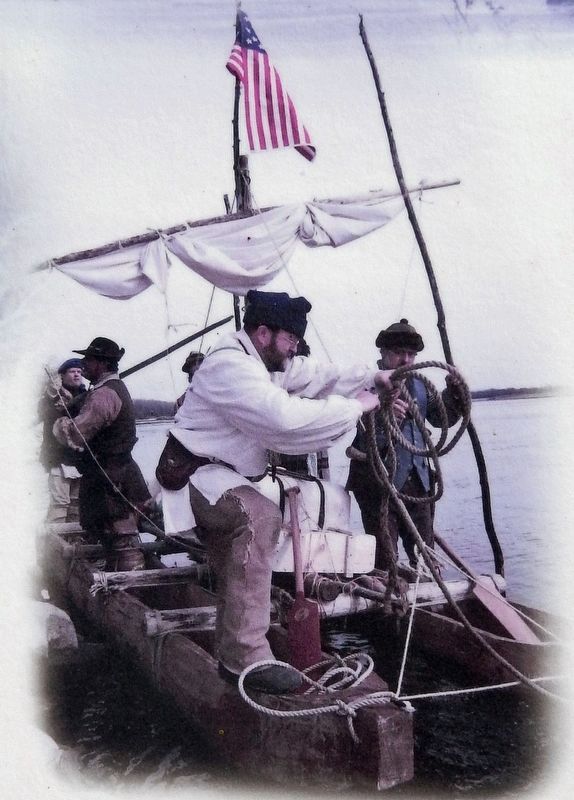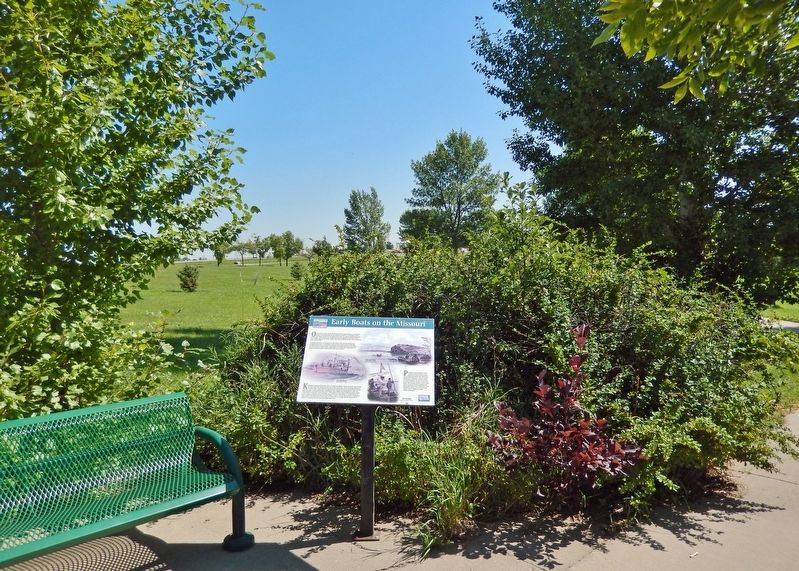Washburn in McLean County, North Dakota — The American Midwest (Upper Plains)
Early Boats on the Missouri
— Washburn Discovery Trail/Lewis & Clark Legacy Trail —
One of the earliest forms of Missouri River transportation was the bull boat. Used primarily by the Mandan, Hidatsa, and Arikara tribes, bull boats served as the main watercraft for natives living along the river banks. These boats were both built and navigated by women. They were built using green willow poles, bent into a circular form, and reinforced with willow ribs.
A buffalo bull hide, stretched over the frame with the fur facing out, completed the boat. The buffalo's tail was not removed from the hide; it indicated the stern or back of the boat. Bull boats varied in size from a one-person boat made with a single hide to a craft that could carry as many as eight people, constructed with several hides.
Keelboats measured between 50 to 70 feet in length, and took their name from the keel that ran along the bottom of the structure. They typically featured a cabin and a sail and traveled both up and down the river, hauling several tons of cargo. Going upstream, a keelboat crew might use wind power, oars, or long poles to push the boat forward. When part of the crew pulled the boat using a tow-line or cordelle, the technique was known as cordelling. A combination of these methods allowed boats to travel fifteen miles a day going upriver. A keelboat was used on the first leg of the Corps of Discovery's voyage up the Missouri in 1804; it returned to St. Louis the following year.
Pirogues were flat-bottomed canoes, built to better withstand the snags and sandbars of the Missouri River. The term also referred to "dugout" canoes, made from carving the wood out from a cut tree trunk to create a canoe-like boat. All wooden vessels were coated with a type of water-repellant tar, and some boats were fabricated from numerous pieces of wood and the seams were caulked to make them watertight.
Erected by Washburn Discovery Trail.
Topics and series. This historical marker is listed in these topic lists: Exploration • Native Americans • Waterways & Vessels • Women. In addition, it is included in the Lewis & Clark Expedition series list.
Location. 47° 18.07′ N, 101° 2.385′ W. Marker is in Washburn, North Dakota, in McLean County. Marker can be reached from 8th Street Southwest just west of State Highway 200, on the left when traveling west. The marker is located along the Washburn Discovery Trail, just east of the Lewis and Clark Interpretive Center. Touch for map. Marker is at or near this postal address: 2576 8th Street Southwest, Washburn ND 58577, United States of America. Touch for directions.
Other nearby markers. At least 8 other markers are within one mile of this marker, measured as the crow flies. Mandan Winter / Harmony Park (about 400 feet away, measured in a direct line); The Washburn Plant (approx. 0.4 miles away); Nettle Creek Country School (approx. 0.6 miles away); Walter R. Hjelle Bridge (approx. 0.8 miles away); Sioux (approx. 0.9 miles away); The Sioux Ferry Boat (approx. 0.9 miles away); Ferry Boats on the Missouri (approx. 0.9 miles away); River Boats on the Missouri (approx. 1.1 miles away). Touch for a list and map of all markers in Washburn.
Related markers. Click here for a list of markers that are related to this marker. Washburn Discovery Trail
Also see . . . Lewis and Clark's Keelboat (Wikipedia). Excerpt:
Lewis and Clark's keelboat was built as a galley in Pittsburgh in 1803 for the Lewis and Clark Expedition, after detailed specifications by Meriwether Lewis. A keelboat, it could be propelled by oars, sails, poles and towlines. The boat was the expedition's main vessel until the spring of 1805, when it was returned to St. Louis. Lewis had designed the keelboat; he supervised its construction, and probably made changes and additions during the building period. It was 55 feet long, with an eight feet beam, and with a shallow draft. The mast was 32 feet high and could be lowered. A ten feet long deck at the bow made a forecastle. A raised aftercastle of the same length contained a cabin. The hold had a capacity of 12 tons.(Submitted on October 26, 2023, by Cosmos Mariner of Cape Canaveral, Florida.)
Credits. This page was last revised on October 27, 2023. It was originally submitted on October 26, 2023, by Cosmos Mariner of Cape Canaveral, Florida. This page has been viewed 60 times since then and 13 times this year. Photos: 1, 2, 3, 4, 5. submitted on October 26, 2023, by Cosmos Mariner of Cape Canaveral, Florida.
